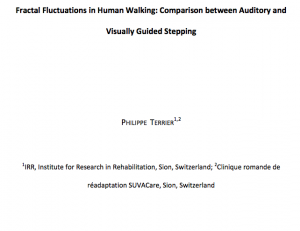
Fractal Fluctuations in Human Walking: Comparison between Auditory and Visually Guided Stepping
Today I read a published paper “Fractal Fluctuations in Human Walking: Comparison between Auditory and Visually Guided Stepping”
The abstract is:
In human locomotion, sensorimotor synchronization of gait consists of the coordination of stepping with rhythmic auditory cues (auditory cueing, AC). AC changes the long-range correlations among consecutive strides (fractal dynamics) into anti-correlations. Visual cueing (VC) is the alignment of step lengths with marks on the floor. The effects of VC on the fluctuation structure of walking have not been investigated. Therefore, the objective was to compare the effects of AC and VC on the fluctuation pattern of basic spatiotemporal gait parameters. Thirty-six healthy individuals walked 3 x 500 strides on an instrumented treadmill with augmented reality capabilities. The conditions were no cueing (NC), AC, and VC. AC included an isochronous metronome. In VC, projected stepping stones were synchronized with the treadmill speed. Detrended fluctuation analysis assessed the correlation structure. The coefficient of variation (CV) was also assessed. The results showed that AC and VC similarly induced a strong anti-correlated pattern in the gait parameters. The CVs were similar between the NC and AC conditions but substantially higher in the VC condition. AC and VC probably mobilize similar motor control pathways and can be used alternatively in gait rehabilitation. However, the increased gait variability induced by VC should be considered.